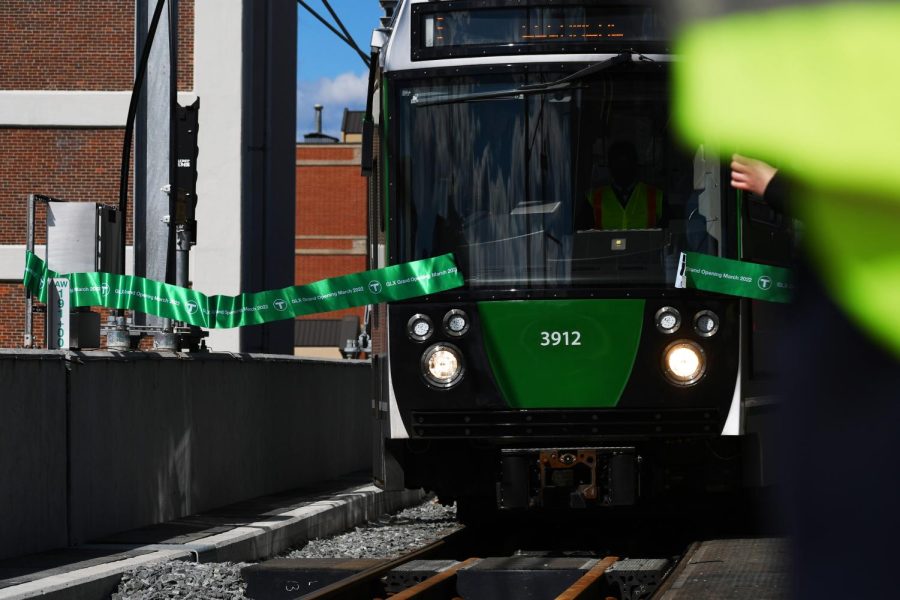Somerville welcomes first phase of Green Line Extension with cautious optimism
A new Green Line trolley cut the ceremonial ribbon as it entered Lechmere station from Union Square, transporting local officials into the opening ceremony for the opening of the Green Line Extension Monday afternoon. Photo credit Avery Bleichfeld.
March 22, 2022
The Union Square Branch of the Green Line Extension, or GLX, opened to the public Monday, with local leaders officiating ribbon-cutting ceremonies at the newly-opened Union Square station and the relocated Lechmere station.
The GLX is a collaboration between the MBTA and the Massachusetts Department of Transportation, or MassDOT. Once fully completed, the new GLX stations will extend the MBTA’s Green Line service from its current terminus in Cambridge to Medford with a total of six new stations and two branches: Union Square and Medford.
MBTA’s Director of Communications Joe Pesaturo said a lot of officials and stakeholders contributed to the making of the GLX with its ups and downs.
“It’s too bad that a lot of people who were here for the beginning of this project, going back decades, are not here now to see this come to fruition. But for the people who are here, and we know for the people of Somerville and Cambridge, this is a very exciting day,” Pesaturo said.
The first train left Union Square station Monday at 4:50 a.m., officially completing the first phase of construction. Near noon, a new Green Line trolley cut the ceremonial ribbon as it entered Lechmere station from Union Square, transporting local officials into the event. Among those in attendance were Gov. Charlie Baker, Lt. Gov. Karyn Polito, Sen. Elizabeth Warren, Rep. Ayanna Pressley, Mayor of Somerville Katjana Ballantyne, Mayor of Cambridge Sumbul Siddiqui, MBTA General Manager Steve Poftak and GLX Program Manager John Dalton.
In her speech, Pressley said transit justice is intersectional to other issues and should be mandatory for residents.
“Transit justice is an issue of consequence for our families — accessing medical care, getting to work on time, picking your kids up from school. Reliable transit isn’t a nice to have, it is a must-have,” Pressley said.
Prior to the GLX opening ceremony, the Community Action Agency of Somerville, or CAAS, held a community press conference titled “Don’t let the Green Line become a gentrification line.” 75 advocates stood in solidarity with Somerville residents who are resisting displacement and gentrification. The press conference was co-sponsored by Union United, City Life/Vida Urbana, Somerville Stands Together and Union Square Neighborhood Council.
CAAS community organizer Isabelle Beauregard primarily works with low-income or immigrant residents who rely on public transportation. They said the event was organized in solidarity with local residents facing housing insecurity due to the rent hikes that come with improved public transportation.
“We want to highlight the fact that we need elected officials at every level of government to take swift and decisive action to make sure that we have some sort of plan in place to mitigate any further displacement and ensure that the most vulnerable residents in Somerville are able to remain,” Beauregard said. “It’s far past time for us to put those policies in place.”
The MBTA and MassDOT have stayed under the proposed $2.3 billion budget for building the GLX. Within the amount, the cities of Cambridge and Somerville fronted $25 million and $50 million respectively towards completing the GLX, along with funds from the federal government.
As part of the scope, a community path along the corridor of the GLX is underway. Pesaturo said pedestrians, dog walkers and bicyclists can share the space, making neighborhoods more walkable.
“A lot of people were worried in 2015, when we were looking to save money on the [GLX] project that it might have to go,” Pesaturo said. “But we were able to find a successful bidder and said, ‘no, we can find a way to build the path, too, along with the Green Line Extension.’ It goes back to the management of the project being able to do that.”
Both Lechmere and Union Square stations have elevators to meet Americans with Disabilities Act standards. On top of that, Pesaturo explained that the 24 newly purchased Green Line cars will have modern amenities with digital screens and will state clear announcements for passengers. With increasing ridership in mind, Pesaturo said capacity is an area the MBTA is also focusing on.
“They’re all being built with extra long train platforms as we get ready for the next generation of Green Line cars,” Pesaturo said. “In just a couple of months, the T will be going out to bid for these new cars, which we call supercars because they’re going to be almost twice the length of the existing Green Line cars. So we’re going to be able to increase capacity significantly up and down the Green Line.”
Pesaturo said the GLX will give Somerville residents more transportation mobility.
“It’s been a difficult time for people. If they have jobs in Boston proper, or even just to come to recreational events, they would have to make a transfer,” Pesaturo said. “Now, they will get that one-seat ride from Union [Square station] to wherever they want to go along the Green Line, which is the most extensive light rail system in the country.”
Public transportation enthusiast Harrison Leong lives near Sullivan Square station on the Orange Line and commutes to Watertown, Jamaica Plain and downtown Boston for work. Leong plans to use the new GLX stations to cut down travel time.
As a follower of the GLX project, Leong hopes the MBTA can take the time to reflect on lessons in its early opening days, especially through the new fare validation system. Currently, riders should validate their tickets at the vending machine before boarding or at the front of T trains where fareboxes are located instead of passing through a turnstile. According to a tweet from the MBTA, the step is temporary as the organization works to implement all-door fare taps on trolleys.
“I’m hoping they can use this time to test that out, see how they can figure out…all the reporting systems and then maybe extend that to the other end of the Green Line. Essentially, you could get on the Green Line vehicle from any door basically, not [where the] operator is,” Leong said.
The MBTA is set to open the Medford branch this summer, including five new stations beyond Lechmere: East Somerville, Gilman Square, Magoun Square, Ball Square and Medford/Tufts. Currently, E line trains will serve the D line Union Square branch until the E line Medford/Tufts branch opens. It has been 35 years since the MBTA opened a new branch — it finished renewing the nine Orange Line stations in May 1987.
The Bay State first committed to building the GLX in 1991 as part of environmental mitigation due to carbon emissions from the Central Artery/Tunnel Project.
Dubbed the Big Dig, the project decongested and rerouted the deteriorating central artery of I-93 by constructing new developments in the city, such as an underground highway, the Rose Kennedy Greenway, Ted Williams Tunnel, as well as the Leonard P. Zakim Bunker Hill Bridge and Tobin Bridge.
The Big Dig resulted in increased traffic and pollution. With the GLX, officials hope air quality will improve and traffic levels will fall — there is a projected reduction in regional daily vehicle miles traveled by 25,728 miles, according to MassDOT.
The GLX is part of an agreement with Boston-based environmental advocacy organization Conservation Law Foundation. However, it may cause a domino effect for surrounding residents: increases in rent. In a 2014 report by the Metropolitan Area Planning Council, rent is projected to increase by 25% to 67% for accommodations along the GLX corridor.
Samantha Wolfe, a community organizer at CAAS, said while the agency is happy to see the GLX launch, she is wary about the consequences residents will face.
“We are thrilled that the Green Line Extension is finally [open]. We applaud the generations of residents and activists who made this possible. At the same time, speculative investment and the lack of protection for residents has already been displacing poor, working-class and even moderate-income residents for the past several years,” Wolfe said.
According to a 2020 report by MassDOT, 26% of the 75,300 residents who live within one-half mile of all GLX stations do not own or have access to an automobile. Beauregard said the skyrocketing rent hikes resulted in a “large exodus of residents” and created an inequitable neighborhood.
“The concern is that because there isn’t surrounding legislation or policies to prevent what’s been going on … the people in Somerville who need access to public transportation are being pushed out farther away from the increasing public transportation that they need,” Beauregard said.
Leong has observed the housing struggle in Boston and beyond and remains persistent. But he said if push comes to shove, residents will find a good alternative.
“I wish the answer was simply to make more money. Of course, it’s never as simple as that. In reality, the answer is probably going to be that some people will get moved. You can at least hope that it’s not an unreasonable distance,” Leong said.
Wolfe said inclusion is important in ensuring vulnerable populations of Somerville and Medford are given a seat at the decision-making table.
“Transit justice is housing justice is racial justice is environmental justice. To me, what that means is that when you have the people who are most impacted by a policy or a development have a say in that and able to take part in the decision making, all of these different factors will be considered,” Wolfe said. “But when … their voices are not even included in the process, you’re going to have development with displacement, instead of development without displacement.”
This story was updated 2:42 p.m. March 22 to clarify Pesaturo’s quote on transportation mobility.








